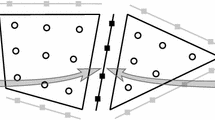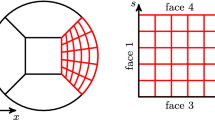Abstract
The paper presents high-order accurate, energy-, and entropy-stable discretizations constructed from summation-by-parts (SBP) operators. Notably, the discretizations assemble global SBP operators and use continuous solutions, unlike previous efforts that use discontinuous SBP discretizations. Derivative-based dissipation and local-projection stabilization (LPS) are investigated as options for stabilizing the baseline discretization. These stabilizations are equal up to a multiplicative constant in one dimension, but only LPS remains well conditioned for general, multidimensional SBP operators. Furthermore, LPS is able to take advantage of the additional nodes required by degree 2p diagonal-norms, resulting in an element-local stabilization with a bounded spectral radius. An entropy-stable version of LPS is easily obtained by applying the projection on the entropy variables. Numerical experiments with the linear-advection and Euler equations demonstrate the accuracy, efficiency, and robustness of the stabilized discretizations, and the continuous approach compares favorably with the more common discontinuous SBP methods.














Similar content being viewed by others
Notes
Assume the Legendre polynomials are normalized to have unit \(L^2\) norm.
Again, the bound requires the assumption that the density and pressure remain positive.
In this work, \(\textsf {H}_{\kappa }\) is 2p exact, but, as was shown in [29], one only needs \(2p-1\) exactness for the operators to exist.
References
Baiocchi, C., Brezzi, F., Franca, L.P.: Virtual bubbles and Galerkin-least-squares type methods (Ga.L.S.). Comput. Methods Appl. Mech. Eng. 105(1), 125–141 (1993). https://doi.org/10.1016/0045-7825(93)90119-i
Barth, T.J.: Numerical methods for gasdynamic systems on unstructured meshes. In: An Introduction to Recent Developments in Theory and Numerics for Conservation Laws, pp. 195–285. Springer (1999)
Becker, R., Braack, M.: A finite element pressure gradient stabilization for the Stokes equations based on local projections. Calcolo 38(4), 173–199 (2001). https://doi.org/10.1007/s10092-001-8180-4
Bezanson, J., Edelman, A., Karpinski, S., Shah, V.B.: Julia: a fresh approach to numerical computing. SIAM Rev. 59(1), 65–98 (2017)
Braack, M., Lube, G.: Finite elements with local projection stabilization for incompressible flow problems. J. Comput. Math. 27(2/3), 116–147 (2009)
Brooks, A.N., Hughes, T.J.R.: Streamline upwind/Petrov-Galerkin formulations for convection dominated flows with particular emphasis on the incompressible Navier–Stokes equations. Comput. Methods Appl. Mech. Eng. 32(1–3), 199–259 (1982). https://doi.org/10.1016/0045-7825(82)90071-8
Burman, E., Fernández, M.A., Hansbo, P.: Continuous interior penalty finite element method for Oseen’s equations. SIAM J. Numer. Anal. 44(3), 1248–1274 (2006). https://doi.org/10.1137/040617686
Burman, E., Hansbo, P.: Edge stabilization for galerkin approximations of convection–diffusion–reaction problems. Comput. Methods Appl. Mech. Eng. 193(15–16), 1437–1453 (2004). https://doi.org/10.1016/j.cma.2003.12.032
Carpenter, M.H., Fisher, T.C., Nielsen, E.J., Frankel, S.H.: Entropy stable spectral collocation schemes for the Navier–Stokes equations: discontinuous interfaces. SIAM J. Sci. Comput. 36(5), B835–B867 (2014). https://doi.org/10.1137/130932193
Chandrashekar, P.: Kinetic energy preserving and entropy stable finite volume schemes for compressible euler and Navier–Stokes equations. Commun. Comput. Phys. 14(5), 1252–1286 (2015). https://doi.org/10.4208/cicp.170712.010313a
Chen, T., Shu, C.W.: Entropy stable high order discontinuous Galerkin methods with suitable quadrature rules for hyperbolic conservation laws. J. Comput. Phys. 345, 427–461 (2017). https://doi.org/10.1016/j.jcp.2017.05.025
Cockburn, B., Hou, S., Shu, C.W.: The Runge-Kutta local projection discontinuous Galerkin finite element method for conservation laws. IV: the multidimensional case. Math. Comput. 54(190), 545–581 (1990). https://doi.org/10.2307/2008501
Cools, R.: Monomial cubature rules since “stroud”: a compilation—part 2. J. Comput. Appl. Math. 112(12), 21–27 (1999). https://doi.org/10.1016/S0377-0427(99)00229-0
Craig Penner, D., Zingg, D.W.: High-order artificial dissipation operators possessing the Summation-By-parts property. In: 2018 Fluid Dynamics Conference. American Institute of Aeronautics and Astronautics (2018). https://doi.org/10.2514/6.2018-4165
Crean, J., Hicken, J.E., Del Rey Fernández, D.C., Zingg, D.W., Carpenter, M.H.: Entropy-stable summation-by-parts discretization of the Euler equations on general curved elements. J. Comput. Phys. 356, 410–438 (2018). https://doi.org/10.1016/j.jcp.2017.12.015
Crean, J., Panda, K., Ashley, A., Hicken, J.E.: Investigation of stabilization methods for multi-dimensional summation-by-parts discretizations of the Euler equations. In: 54th AIAA Aerospace Sciences Meeting, p. 13. San Diego, California, United States. AIAA 2016-1328 (2016). https://doi.org/10.2514/6.2016-1328
Dafermos, C.M.: Hyperbolic Conservation Laws in Continuum Physics, vol. 325. Springer, Berlin (2010). https://doi.org/10.1007/978-3-642-04048-1
Del Rey Fernández, D.C., Boom, P.D., Zingg, D.W.: A generalized framework for nodal first derivative summation-by-parts operators. J. Comput. Phys. 266(1), 214–239 (2014)
Del Rey Fernández, D.C., Crean, J., Carpenter, M.H., Hicken, J.E.: Staggered-grid entropy-stable multidimensional summation-by-parts discretizations on curvilinear coordinates. J. Comput. Phys. 392, 161–186 (2019). https://doi.org/10.1016/j.jcp.2019.04.029
Del Rey Fernández, D.C., Hicken, J.E., Zingg, D.W.: Review of summation-by-parts operators with simultaneous approximation terms for the numerical solution of partial differential equations. Comput. Fluids 95(22), 171–196 (2014)
Del Rey Fernández, D.C., Hicken, J.E., Zingg, D.W.: Simultaneous approximation terms for multi-dimensional summation-by-parts operators. J. Sci. Comput. 74, 83–110 (2017). https://doi.org/10.1007/s10915-017-0523-7
Douglas, J., Dupont, T.: Interior penalty procedures for elliptic and parabolic Galerkin methods computing methods in applied sciences. In: Glowinski, R., Lions, J.L. (eds.) Computing Methods in Applied Sciences. Lecture Notes in Physics, chap. 6, vol. 58, pp. 207–216. Springer, Berlin (1976). https://doi.org/10.1007/bfb0120591
Fisher, T.C.: High-order l2 stable multi-domain finite difference method for compressible flows. Ph.D. thesis, Purdue University (2012)
Fisher, T.C., Carpenter, M.H.: High-order entropy stable finite difference schemes for nonlinear conservation laws: finite domains. J. Comput. Phys. 252, 518–557 (2013). https://doi.org/10.1016/j.jcp.2013.06.014
Fisher, T.C., Carpenter, M.H., Nordström, J., Yamaleev, N.K., Swanson, C.: Discretely conservative finite-difference formulations for nonlinear conservation laws in split form: theory and boundary conditions. J. Comput. Phys. 234, 353–375 (2013). https://doi.org/10.1016/j.jcp.2012.09.026
Gassner, G.J.: A skew-symmetric discontinuous Galerkin spectral element discretization and its relation to SBP-SAT finite difference methods. SIAM J. Sci. Comput. 35(3), A1233–A1253 (2013). https://doi.org/10.1137/120890144
Hartmann, R.: Adjoint consistency analysis of discontinuous Galerkin discretizations. SIAM J. Numer. Anal. 45(6), 2671–2696 (2007). https://doi.org/10.1137/060665117
Hesthaven, J.S., Warburton, T.: Nodal Discontinuous Galerkin Methods: Algorithms, Analysis, and Applications. Springer, New York (2008)
Hicken, J.E., Del Rey Fernández, D.C., Zingg, D.W.: Multi-dimensional summation-by-parts operators: general theory and application to simplex elements. SIAM J. Sci. Comput. 38(4), A1935–A1958 (2016)
Hicken, J.E., Zingg, D.W.: Summation-by-parts operators and high-order quadrature. J. Comput. Appl. Math. 237(1), 111–125 (2013). https://doi.org/10.1016/j.cam.2012.07.015
Hicken, J.E., Zingg, D.W.: Dual consistency and functional accuracy: a finite-difference perspective. J. Comput. Phys. 256, 161–182 (2014). https://doi.org/10.1016/j.jcp.2013.08.014
Hughes, T.J.R.: Multiscale phenomena: Green’s functions, the Dirichlet-to-Neumann formulation, subgrid scale models, bubbles and the origins of stabilized methods. Comput. Methods Appl. Mech. Eng. 127, 387–401 (1995). https://doi.org/10.1016/0045-7825(95)00844-9
Hughes, T.J.R., Franca, L.P., Hulbert, G.M.: A new finite element formulation for computational fluid dynamics: VIII. The Galerkin/least-squares method for advective-diffusive equations. Comput. Methods Appl. Mech. Eng. 73(2), 173–189 (1989). https://doi.org/10.1016/0045-7825(89)90111-4
Hughes, T.J.R., Franca, L.P., Mallet, M.: A new finite element formulation for computational fluid dynamics: I. Symmetric forms of the compressible Navier–Stokes equations and the second law of thermodymaics. Comput. Methods Appl. Mech. Eng. 54(2), 223–234 (1986)
Hunter, J.D.: Matplotlib: a 2D graphics environment. Comput. Sci. Eng. 9(3), 90–95 (2007). https://doi.org/10.1109/MCSE.2007.55
Ismail, F., Roe, P.L.: Affordable, entropy-consistent euler flux functions II: entropy production at shocks. J. Comput. Phys. 228(15), 5410–5436 (2009). https://doi.org/10.1016/j.jcp.2009.04.021
Jameson, A., Schmidt, W., Turkel, E.: Numerical solution of the Euler equations by finite volume methods using Runge–Kutta time-stepping schemes. In: 14th Fluid and Plasma Dynamics Conference. Palo Alto, CA (1981)
Jones, E., Oliphant, T., Peterson, P., et al.: SciPy: open source scientific tools for Python (2001–). http://www.scipy.org/
Liu, Y., Vinokur, M.: Exact integrations of polynomials and symmetric quadrature formulas over arbitrary polyhedral grids. J. Comput. Phys. 140(1), 122–147 (1998). https://doi.org/10.1006/jcph.1998.5884
Lu, J.C.: An a posteriori error control framework for adaptive precision optimization using discontinuous Galerkin finite element method. Ph.D. thesis, Massachusetts Institute of Technology, Cambridge, Massachusetts (2005)
Mattsson, K., Svärd, M., Nordström, J.: Stable and accurate artificial dissipation. J. Sci. Comput. 21(1), 57–79 (2004)
Oliphant, T.E.: A Guide to NumPy, vol. 1. Trelgol Publishing USA (2006)
Parsani, M., Carpenter, M.H., Fisher, T.C., Nielsen, E.J.: Entropy stable staggered grid discontinuous spectral collocation methods of any order for the compressible Navier–Stokes equations. SIAM J. Sci. Comput. 38(5), A3129–A3162 (2016). https://doi.org/10.1137/15m1043510
Pulliam, T.H.: Artificial dissipation models for the Euler equations. AIAA J. 24(12), 1931–1940 (1986)
Ranocha, H., Glaubitz, J., Öffner, P., Sonar, T.: Stability of artificial dissipation and modal filtering for flux reconstruction schemes using summation-by-parts operators. Appl. Numer. Math. 128, 1–23 (2018). https://doi.org/10.1016/j.apnum.2018.01.019
Svärd, M., Nordström, J.: Review of summation-by-parts schemes for initial-boundary-value-problems. J. Comput. Phys. 268(1), 17–38 (2014)
Svärd, M., Özcan, H.: Entropy-stable schemes for the Euler equations with far-field and wall boundary conditions. J. Sci. Comput. 58(1), 61–89 (2013). https://doi.org/10.1007/s10915-013-9727-7
Tadmor, E.: The numerical viscosity of entropy stable schemes for systems of conservation laws I. Math. Comput. 49(179), 91–103 (1987)
Tadmor, E.: Entropy stability theory for difference approximations of nonlinear conservation laws and related time-dependent problems. Acta Numer. 12, 451–512 (2003). https://doi.org/10.1017/s0962492902000156
Van Der Walt, S., Colbert, S.C., Varoquaux, G.: The NumPy array: a structure for efficient numerical computation. Comput. Sci. Eng. 13(2), 22 (2011)
Acknowledgements
My sincerest thanks to my students—Anthony Ashley, Tucker Babcock, Garo Bedonian, Luiz Cagliari, Jared Crean, Sharanjeet Kaur, Kinshuk Panda, Ge Yan, and Jianfeng Yan—for their feedback on an early draft of this paper. I am also grateful to the anonymous reviewers for their careful reading of the manuscript and helpful comments. All the results in this paper were obtained using software written in Julia [4]. The plots were generated using Matplotlib [35], with help from the Numpy [42, 50] and Scipy [38] libraries.
Author information
Authors and Affiliations
Corresponding author
Additional information
Publisher's Note
Springer Nature remains neutral with regard to jurisdictional claims in published maps and institutional affiliations.
Appendix: Eigenvalues and eigenvectors of the LPS operator
Appendix: Eigenvalues and eigenvectors of the LPS operator
Theorem 4
Consider an element in dimension d, whose \(n_{\kappa }\) nodes and norm \(\textsf {H}_{\kappa }\) define a degree 2p exact cubature rule. Let \(\textsf {L}\) denote the orthogonal polynomials of total degree p on the element domain evaluated at the nodes of the element, and define the LPS dissipation operator \(\textsf {M}_{\kappa }^{\textsf {P}}= \left( \textsf {P}_{\kappa }\right) ^T \textsf {H}_{\kappa }\textsf {P}_{\kappa }\), with unit scaling matrix, \(\textsf {A}_{\kappa } = \textsf {I}\). Then the eigenvalues of \(\textsf {H}_{\kappa }^{-1} \textsf {M}_{\kappa }^{\textsf {P}}\) are \(\lambda _0 = 0\), with multiplicity \({p + d} \atopwithdelims (){d}\), and \(\lambda _1 =1\), with multiplicity \(n_{\kappa }- {{p + d} \atopwithdelims (){d}}\). The eigenvectors corresponding to \(\lambda _0\) are \(\textsf {L}\) and the eigenvectors corresponding to \(\lambda _1\) are in the nullspace of \(\textsf {L}^T \textsf {H}_{\kappa }\).
Proof
The first step in the proof is to find the eigenvalues of the projection operator, \(\textsf {P}_{\kappa }= \textsf {I} - \textsf {L} \textsf {L}^T \textsf {H}_{\kappa }\). It is easy to show that the columns of \(\textsf {L}\) are eigenvectors of \(\textsf {P}_{\kappa }\) corresponding to eigenvalues \(\lambda _0=0\):
where we used the orthogonality of the \(\textsf {L}\) and the exactness of the cubature for polynomials of degree 2p or less. Now, let \(\textsf {V}\) denote an orthonormal basis for the nullspace of \(\textsf {L}^T \textsf {H}_{\kappa }\). Since there are \({p + d} \atopwithdelims (){d}\) linearly independent vectors in \(\textsf {L}\), and \(\textsf {H}_{\kappa }\) is full rank, the nullspace has dimension \(n_{\kappa }- {{p + d} \atopwithdelims (){d}}\). Furthermore, the columns of \(\textsf {V}\) are also eigenvectors of \(\textsf {P}_{\kappa }\) with associated eigenvalues \(\lambda _1=1\):
since \(\textsf {V}\) is in the nullspace of \(\textsf {L}^T \textsf {H}_{\kappa }\).
The second, and final, step in the proof is to show that \(\textsf {H}_{\kappa }^{-1} \textsf {M}_{\kappa }^{\textsf {P}}= \textsf {P}_{\kappa }^2\), from which it follows that the desired eigenvalues are the square of those of \(\textsf {P}_{\kappa }\). To this end,
where we used the symmetry of \(\textsf {H}_{\kappa }\) in the second last line above. Thus, based on this result and the eigenvalues of \(\textsf {P}_{\kappa }\), we must have \(\left( \textsf {H}_{\kappa }^{-1} \textsf {M}_{\kappa }^{\textsf {P}}\right) \textsf {L} = \textsf {0}\) and \(\left( \textsf {H}_{\kappa }^{-1} \textsf {M}_{\kappa }^{\textsf {P}}\right) \textsf {V}\) = \(\textsf {V}\), which completes the proof. \(\square \)
Rights and permissions
About this article
Cite this article
Hicken, J.E. Entropy-Stable, High-Order Summation-by-Parts Discretizations Without Interface Penalties. J Sci Comput 82, 50 (2020). https://doi.org/10.1007/s10915-020-01154-8
Received:
Revised:
Accepted:
Published:
DOI: https://doi.org/10.1007/s10915-020-01154-8




